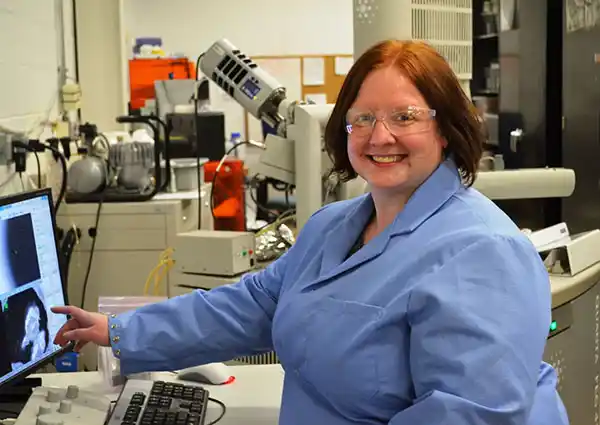Improving trace explosives detection of fingerprint residues
Meet Melissa Sweat
Almost all of us have been there, particularly if we are frequent travelers. The long lines and meticulous processing at airport security checkpoints are familiar. Most passengers want to get through security screenings as quickly as possible. How many people have wondered how those security screenings work? Trace explosives detection, a crucial tool in the prevention of terror attacks, is used by airport security systems and in a variety of industries.

Melissa Sweat conducted research pertaining to the development of an algorithm to digitally isolate and characterize explosive particles found in fingerprint residues. Sweat’s research focused on understanding the characteristics of trace explosive particles on fingerprints from various surfaces.
So what exactly is trace explosives detection and how can it be used effectively? Can the technology be improved to enhance the security and safety of Americans? The latter question is what Melissa Sweat, Ph.D., tackled during her appointment with the U.S. Department of Homeland Security (DHS) Transportation Security Laboratory (TSL) Visiting Scientist Program.
The program is designed to provide opportunities for research, development and education on DHS mission-relevant science for academics on multiple levels, ranging from undergraduates and graduate students to postdoctoral students and visiting faculty members. The program seeks to enhance the quantity, quality and diversity of the future DHS scientific and engineering workforce.
Sweat researched under the mentorship of Richard Lareau, Ph.D., chief scientist, and Barry Smith, Ph.D., electromagnetic technology lead, at the Transportation Security Laboratory, Atlantic City, New Jersey. Sweat has a doctorate in chemical engineering from Purdue University with a specialty in explosives and material science.
Sweat conducted research pertaining to the development an algorithm to digitally isolate and characterize explosive particles found in fingerprint residues. When an individual handles explosives and then touches another object, such as a door handle or briefcase, some of the explosive residue is transferred to the object. While the residue is largely invisible to the naked eye, it is detectable with specialized instruments. Sweat’s research focused on understanding the characteristics of trace explosive particles on fingerprints from various surfaces.
Trace explosives detection can be implemented through contact or non-contact sampling where particles or vapors are transmitted to a detector. Both methods benefit from an understanding of particle size distribution of explosive materials. In order to effectively find particles and study their variable size and shape distribution, Sweat developed a new technique to better evaluate the particle size distribution using scanning electron microscopy (SEM). Because the particles of interest are so small, sometimes 10 times smaller than the width of a human hair, a highly powered SEM was used for the analysis. Sweat also developed an image processing script that would automatically process the SEM images instead of processing them by hand.
Sweat’s research contributes to a better understanding and detection of explosive particles in fingerprints. In turn, those efforts can lead to the development of better instruments specifically used by security at airports.
Prior to her appointment with TSL, Sweat had limited knowledge of programming. During her experience, she had the opportunity to expand her coding skills, collaborate with individuals across disciplines and train on advanced analytical equipment.
Sweat accepted a position as a specialist with Anton Parr, a company that develops and manufactures analytical instruments for research and industry. She joined the particle and materials characterization group, where she trains others to use scientific instruments.
The DHS TSL Visiting Scientist Program is administered by the Oak Ridge Institute for Science and Education (ORISE). ORISE is a U.S. Department of Energy (DOE) asset managed by Oak Ridge Associated Universities (ORAU) through a contract between ORAU and DOE.

